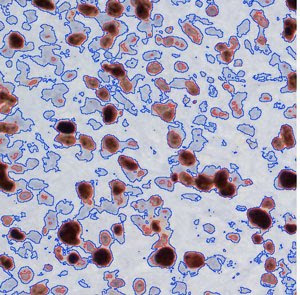published the code for a free Web application,
called ImageJS. It lets pathologists analyze digitized pathology slides for malignancy
based on how cancer cells change color when exposed to standard dyes. More
exciting in some ways are future ImageJS modules that promise to deliver
genomics analysis and to let doctors compare their patient’s data to similar
cases stored in national databases in real time while keeping it private.
Why should we care? Such future comparisons will make your diagnoses
more accurate and rule out treatments that won’t work with your genetic
signature, sparing you misery.
Most importantly, the system should
realize the promise of Big Data, Web 3.0, cloud computing, the one world
computer and the semantic Web. What?
Many laymen, including me, and some researchers,
have little idea about what those things are or what they will mean for healthcare
and research in the coming years. Our bioinformatics guy, Dr. Jonas Almeida,
tried to help me prepare to write my
article on his new system by suggesting I read The Big Switch by
Nicolas Carr.
The book adroitly explained the above tech jargon, but my understanding
remains basic and my attempts to clearly summarize Dr. Almeida’s work
imperfect. Maybe we should have broken the story into a series to make its
complexity more digestible, or done separate versions for programmers, cancer docs and patients. Still, we did our best and
look forward to your thoughts.
By the way, cloud computing is much in
the news, but coverage is more likely to focus on gaming than
medicine. We had hoped that the tech pundits might use our publication as
excuse to cover open coding or the cloud in medicine, but the ImageJS system is
only a research prototype.
Neither should we argue too forcibly
for the immediate importance of this work because bioinformatics as a whole is
still in its relative infancy, with plenty of potential for overstatement. Dr. Almeida is the first to argue that ImageJS
will only become significant if it becomes popular with pathologists and
biostatisticians nationwide.
As consumers, we can choose from free Web
applications by the hundreds, most of them games. Here’s hoping our doctors
will soon have access to such cheap and powerful technologies as they care for
us. At least Dr. Almeida has made a
start. Just like Angry Birds or Instagram, the ImageJs modules are available at
the Google Chrome App
store.
PS: Under the broader heading of medical research and social computing, check out this article on 23andMe in the Nature blog Spoonful of Medicine.
PS: Under the broader heading of medical research and social computing, check out this article on 23andMe in the Nature blog Spoonful of Medicine.


No comments:
Post a Comment
We encourage and look forward to your comments on The Mix (and in its related social networking outposts).
Comments will be reviewed before they're posted. Those that are not related to the topic under discussion, promote products or use profanity or abusive language will not be included.